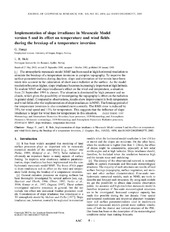Implementation of slope irradiance in Mesoscale Model version 5 and its effect on temperature and wind fields during the breakup of a temperature inversion
Peer reviewed, Journal article
Permanent lenke
https://hdl.handle.net/1956/417Utgivelsesdato
2003-01-24Metadata
Vis full innførselSamlinger
- Geophysical Institute [1198]
Originalversjon
https://doi.org/10.1029/2002jd002575Sammendrag
The atmospheric mesoscale model MM5 has been used at high horizontal resolution to simulate the breakup of a temperature inversion in complex topography. To improve the surface parameterizations during daytime, slope and orientation of the terrain have been taken into account in the calculation of short wave radiation at the surface. As the model resolution becomes higher, slope irradiance becomes increasingly important at high latitude. To evalute MM5 and slope irradiance’s effect on the wind and temperature, a situation from 21 September 1994 is chosen. The situation is dominated by high pressure and no clouds, which gives the possibility of investigating the topography’s effect on the radiation in greater detail. Compared to observations, results show improvement in both temperature and wind fields after the implementation of slope irradiances in MM5. The breakup period of the temperature inversion is also simulated more correctly. The RMS error is reduced by 35% for wind speed and 13% for temperature. This suggests that the influence of slope irradiance is larger for wind than for temperature in this situation.
